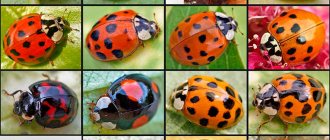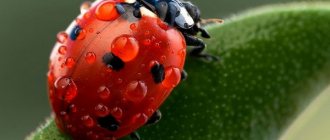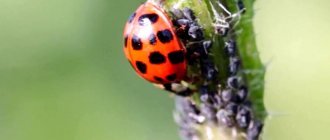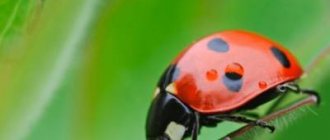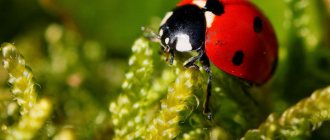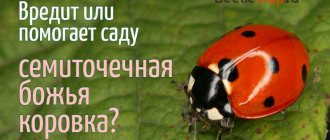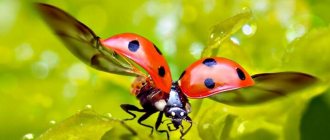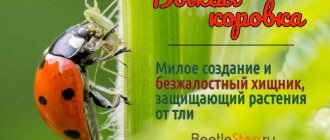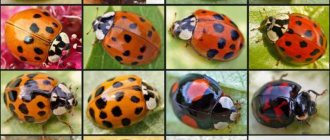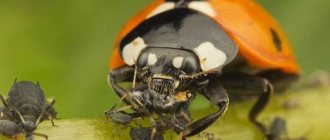Black eresus (Eresus kollari) is a poisonous spider with a unique appearance. It is also sometimes called "black fathead". This species belongs to the Eresidae family. Spider bites are dangerous for both people and pets. It is necessary to take into account that black eresus is listed in the Red Book, so killing the arachnid is strictly not recommended.
Eresus black or black fathead, appearance
What does an eresus spider look like: photo
Eresus: ladybug spider.
Description of the Erasus spider
Name: Eresus or Black fathead Lat.:
Eresus kollariClass: Arachnida - Arachnida Order: Spiders - Araneae Family: Eresidae - Eresidae
| Habitats: | dry steppes and deserts |
| Dangerous for: | insects and small arachnids |
| Attitude towards people: | They don’t harm, but they bite painfully. |
Are you afraid of spiders?
TerribleNo
The size of the female individual is from 8 to 18 mm. The body is compact and round with short thick legs. The color is velvety black. Small light hairs are present. Males have a body length of 6 to 8 mm. The color is very bright. The cephalothorax is black with sparse light hairs. The hairs form the basis of white narrow rings.
The belly has a rounded shape. In the upper part it is painted bright red. In this area there are 4 black spots, similar in appearance to a button. The bottom and sides are black. The hind two pairs of paws may be spotted with red.
Biological characteristics
In official biological language, argiope belongs to the family of orb-weaving spiders. This family is characterized by the production of a large circular catch net with a pronounced spiral stabilimentum in the center. This section of the web is clearly visible in ultraviolet rays, which are distinguishable by many insects, and therefore the stablimentum is so attractive to various insects and beetles.
Reference! Stabilimentum - threads of the web that form a zigzag pattern.
Appearance
According to the description, the Argiope spider really looks like a wasp or a zebra. The body of the arthropod clearly shows an alternation of black and yellow stripes, however, this is characteristic only of females. Males of this species are small and inconspicuous.
Argiope Brünnich spiders exhibit pronounced dimorphism. The female has a body size of 15-30 millimeters in length, while the male Argiope barely reaches half a centimeter.
Spreading
This striped black and yellow spider mainly inhabits the middle and southern regions of Europe and Russia. But recently, thanks to climate warming, argiope has begun to be found in the northern regions. There is information that our spider was seen in the Moscow and Nizhny Novgorod regions, and even further north.
Lifestyle
The usual colony of Argiope settles in forests or meadows. where there is a massive number of potential casualties. The number of one settlement is usually about two dozen spiders.
A yellow striped spider weaves its webs in the twilight evening. He spends no more than one hour making his trap. After the web is woven, its owner is placed in the center of the network and, taking the shape of the letter "X", awaits the victim.
It should be noted that the Argiope catching net is very beautiful; it is distinguished by the presence of a pronounced circular shape and small cells, through which even the smallest mosquito cannot break through.
Nutrition
The zebra argiope spider feeds on the insects that fall into its web. These are mainly numerous Orthoptera, although various flies or mosquitoes often find themselves in the web. The spiders inject poison into them and entwine them with cobwebs, then they suck the juices from the victim’s body, which has begun to dissolve.
Reproduction
The female reaches the age of sexual reproduction after the last molt of her development. During mating, the female wraps a web around the male, and if he fails to get out, then his fate is unenviable - he will certainly be eaten.
And the female will then weave a large cocoon, into which she will place her numerous eggs, which she guards with the care of a loving mother.
At the beginning of autumn, the spiderlings emerge from the cocoon, and, being attached to the webs, are carried by the wind around the area, thus creating new colonies of spiders.
Attention! Flying webs during Indian summer, among other things, are a way for spiders to spread in open areas.
In other cases, the female can lay eggs, and there are up to a hundred of them in one cocoon, in late autumn, and the young spiders hatch and settle with the arrival of spring. The female herself does not overwinter, but, having laid eggs, dies.
Diet and lifestyle
The Eresus spider leads a secretive lifestyle and rarely appears on the surface of the earth. They can occupy the beetles' home, but they are also capable of digging a deep hole themselves. The nest is a web-like tube located in the ground. Basically, the black eresus lives in a hole. Females are in the shelter all the time. Only young individuals and adult males emerge from the burrows during the mating period.
Webs are a network for the victim. Future food gets caught there and gets stuck, which the female catches and prepares for consumption. Arthropods feed on:
- insects;
- beetles;
- flies;
- butterflies;
- centipedes;
- woodlice;
- scorpions;
- lizards.
ONE OF A KIND
Spiders of the eresid family live mainly in the tropics. The black fathead, also known as black eresus, is the only European species. Its range covers vast territories from the Iberian Peninsula to Novosibirsk. The spider can be found in central Russia, Crimea, the Caucasus, the southern part of the Urals and Central Asia, but is very rare everywhere.
The cephalothorax of eresids in both males and females is black and velvety. The head part is raised high above the chest and looks square from above. The eight eyes are arranged in three rows, with one pair, set back and to the sides, being significantly larger than the others. The body is covered with a dense layer of short feathery hairs, which is why the spider looks velvety. The legs are powerful, also black, with white rings in the male.
Life cycle
Eresus spider black.
Males leave their burrows in search of a mate. The courtship period takes place over several hours. The males are dancing. At the same time, they form a protein liquid, which leads the female to a catalytic state. The pedipalps transport seminal fluid into the genital opening.
If there are several males, a duel begins. For 2 months after fertilization, males live in burrows with females. The female is engaged in the manufacture of a cocoon. There can be about 80 eggs in a cocoon.
The female weaves insect skin, grass, and leaves into the cocoon to disguise it. During the day she warms him under the bright rays of the sun, and at night she takes him to shelter. The lifespan of a female is 1.5 years, and a male is 8 months.
Larvae
Coccinellid larvae belong to the campodeoid type - they are mobile, have an elongated body and three pairs of long thoracic legs. The appearance of the larvae of members of the family is very diverse. The larvae of most Palaearctic species belong to the so-called coccinelloid type, which is characterized by a fusiform body shape, a large head and long legs.
The head of the larvae is rounded and quadrangular, approximately the same width and length. Its sides are rounded to one degree or another or straight. There are antennae on the head. Two-segmented and single-segmented antennae are characteristic of specialized genera that feed on pseudoscale insects. Variations in the structure of the antennae are represented by a combination in different combinations of different lengths of the basal and apical segments (genus Hyperaspis
,
Nephus
).
The mandibles of the larvae are triangular or sickle-shaped, protruding or slightly protruding. Mandibles according to their structure can be divided into 2 types. The first - multi-toothed, triangular in shape, with an absent retinacula - are characteristic of species ( Subcoccinella
) with a herbivorous lifestyle. Mandibles of the second type are characteristic of Coccinellinae; they are sickle-shaped, have 1-2 sharp teeth at the apex, and the retinacula is developed. There are three simple eyes on the sides of the head. The abdomen is 10-segmented, without caudal filaments at the end. The legs are long, wider than the body. The dorsum has various structures, armed with setae, or covered with white waxy threads.
The prothorax is much longer and narrower than the mesothorax and metathorax. The dorsum of the prothorax has 2 or 4, rarely 6 scutes - square, rounded-square or elongated, placed longitudinally. The dorsum of the mesothorax and metathorax have 2 scutes of an oval oblong, less often round shape, located across the segments. On their outer edges the scutes are covered with various setae.
Legs are elongated. The abdomen is formed by 10 segments, the last of which is shifted to the ventral side and has the shape of a sucker. The tergite of segment IX is most often rounded at its apex, sometimes with a cone-shaped or triangular outgrowth. The integumentary formations on the abdomen of larvae are extremely diverse and can be used as important taxonomic characters. They are represented by: warts, outgrowths of various shapes and bristles.
The larvae go through four instars. Larvae of the first instar are small in size, length from 0.5 to 1.2-1.7 mm. At the fourth instar, the length of the larvae is 5-8 mm, and some - 17-18 mm. Larvae of the first instar usually have a single color - dark or gray with white, yellow, orange or red spots. At older ages, the larvae acquire bright and varied colors. Bright coloring is characteristic, as a rule, of species that feed on aphids and live openly in their colonies. There is a relationship between color and their behavior: the more active the larva, the brighter its color (genus Coccinella, Coccinula, Anatis
,
Harmonia axyridis
,
Aiolocaria mirabilis
, with a contrasting combination of rich black color with orange spots and stripes). Single-colored, often dark larvae are characteristic of ladybugs that feed on pseudoscale insects. The color of the larvae is subject to age and individual variability.
Beetles and larvae of most species are entomophagous predators. Only a few species eat plant foods.
Eresus bites
The venom of the Eresus spider is considered strong and dangerous. The spider kills its prey in seconds. For humans, the bite is very painful, but not fatal. The spider stings painfully and injects a large portion of poison.
Black fathead.
Symptoms of a bite are:
- sharp pain;
- swelling;
- numbness of the bite site;
- strong pain.
Hunter's fringe (Dolomedes fimbrata)
It is a superb predator and one of the largest spiders in Britain. These spiders settle in close proximity to water, on the banks of slow-flowing rivers, lakes and swamps. It moves along the water surface using the surface tension of the water and the fluff on the tips of its paws. When moving, the second and third pair of limbs are used, which do not straighten and rotate slightly. In case of danger, the spider can hide under water; when immersed, the body, covered with shaggy hairs, becomes covered with air bubbles. When emerging, the bubbles burst, but the hunter remains dry. The hunter is a web crawler, using the surface of the water in the same way that other spiders use webs. Sensitive hairs growing on their front legs help them detect movement in the water. When they sense insect vibrations, spiders will ambush or pursue the insect at short distances. The predator then grabs the prey and injects poison into its body. It eats it on the shore, sometimes it takes several hours for the victim to be digested.
The mating season is from May to June. The male waits for the female to catch the prey and is busy eating it; at this moment he carefully approaches her and mating occurs. The eggs are attached by the spider to nearby vegetation. She carefully guards them and, if necessary, moves them to another place. The emerging nymphs live in this form for about two years, often far from water. Then they molt and take on the appearance of adult animals; after a year, a second molt occurs and the spider becomes sexually mature. After breeding, the spider dies.
